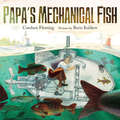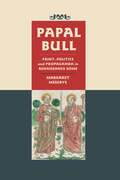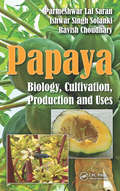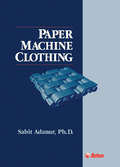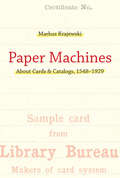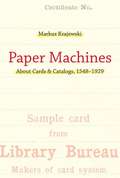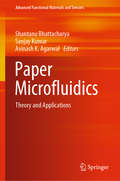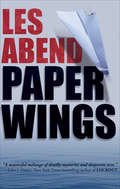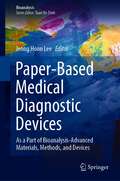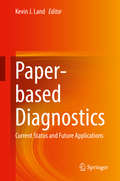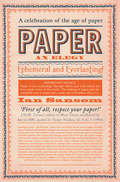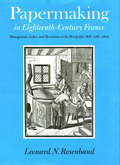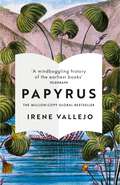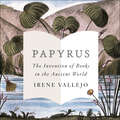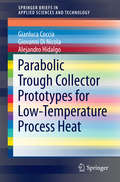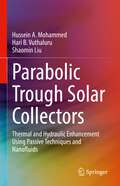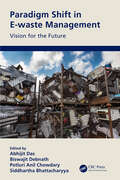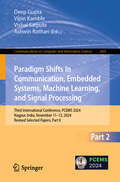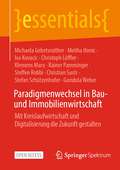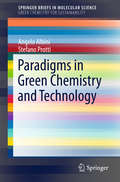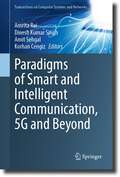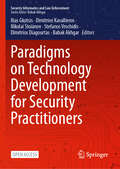- Table View
- List View
Papa's Mechanical Fish
by Candace FlemingCandace Fleming and illustrator Boris Kulikov pair up to tell a fun story about a real submarine inventor in Papa's Mechanical FishClink! Clankety-bang! Thump-whirr! That's the sound of Papa at work. Although he is an inventor, he has never made anything that works perfectly, and that's because he hasn't yet found a truly fantastic idea. But when he takes his family fishing on Lake Michigan, his daughter Virena asks, "Have you ever wondered what it's like to be a fish?"—and Papa is off to his workshop. With a lot of persistence and a little bit of help, Papa—who is based on the real-life inventor Lodner Phillips—creates a submarine that can take his family for a trip to the bottom of Lake Michigan.
Papal Bull: Print, Politics, and Propaganda in Renaissance Rome (Singleton Center Books in Premodern Europe)
by Margaret MeserveHow did Europe's oldest political institution come to grips with the disruptive new technology of print?Printing thrived after it came to Rome in the 1460s. Renaissance scholars, poets, and pilgrims in the Eternal City formed a ready market for mass-produced books. But Rome was also a capital city—seat of the Renaissance papacy, home to its bureaucracy, and a hub of international diplomacy—and print played a role in these circles, too. In Papal Bull, Margaret Meserve uncovers a critical new dimension of the history of early Italian printing by revealing how the Renaissance popes wielded print as a political tool. Over half a century of war and controversy—from approximately 1470 to 1520—the papacy and its agents deployed printed texts to potent effect, excommunicating enemies, pursuing diplomatic alliances, condemning heretics, publishing indulgences, promoting new traditions, and luring pilgrims and their money to the papal city. Early modern historians have long stressed the innovative press campaigns of the Protestant Reformers, but Meserve shows that the popes were even earlier adopters of the new technology, deploying mass communication many decades before Luther. The papacy astutely exploited the new medium to broadcast ancient claims to authority and underscore the centrality of Rome to Catholic Christendom. Drawing on a vast archive, Papal Bull reveals how the Renaissance popes used print to project an authoritarian vision of their institution and their capital city, even as critics launched blistering attacks in print that foreshadowed the media wars of the coming Reformation. Papal publishing campaigns tested longstanding principles of canon law promulgation, developed new visual and graphic vocabularies, and prompted some of Europe's first printed pamphlet wars. An exciting interdisciplinary study based on new literary, historical, and bibliographical evidence, this book will appeal to students and scholars of the Italian Renaissance, the Reformation, and the history of the book.
Papaya: Biology, Cultivation, Production and Uses
by Parmeshwar Lal Saran Ishwar Singh Solanki Ravish ChoudharyWith coverage that ranges from basic information to advanced research, Papaya: Biology, Cultivation, Production and Uses pulls together the vast literature scattered over various sources into one practical resource. The book provides a solid review of papaya biology, production, and uses supported by color photographs and illustrations. It covers p
Paper Machine Clothing: Key to the Paper Making Process
by Sabit AdanurEveryone involved in paper making knows Asten as a world class manufacturer of paper machine clothing. Perhaps less well known is that Asten started in this industry more than 120 years ago. Since then the company has taken advantage of modern manufacturing techniques to produce innovative products needed by the growing paper making industry. That is why Asten commissioned Dr. Sabit Adanur to write this book - to continue spreading sophisticated papermaking knowledge throughout the global paper industry. This book discusses how the latest technological innovations help produce quality paper products. It also covers the use of TQM and computers in the papermaking process as basic paper structure and properties.
Paper Machines: About Cards & Catalogs, 1548-1929 (History and Foundations of Information Science)
by Markus KrajewskiWhy the card catalog—a “paper machine” with rearrangeable elements—can be regarded as a precursor of the computer.Today on almost every desk in every office sits a computer. Eighty years ago, desktops were equipped with a nonelectronic data processing machine: a card file. In Paper Machines, Markus Krajewski traces the evolution of this proto-computer of rearrangeable parts (file cards) that became ubiquitous in offices between the world wars. The story begins with Konrad Gessner, a sixteenth-century Swiss polymath who described a new method of processing data: to cut up a sheet of handwritten notes into slips of paper, with one fact or topic per slip, and arrange as desired. In the late eighteenth century, the card catalog became the librarian's answer to the threat of information overload. Then, at the turn of the twentieth century, business adopted the technology of the card catalog as a bookkeeping tool. Krajewski explores this conceptual development and casts the card file as a “universal paper machine” that accomplishes the basic operations of Turing's universal discrete machine: storing, processing, and transferring data. In telling his story, Krajewski takes the reader on a number of illuminating detours, telling us, for example, that the card catalog and the numbered street address emerged at the same time in the same city (Vienna), and that Harvard University's home-grown cataloging system grew out of a librarian's laziness; and that Melvil Dewey (originator of the Dewey Decimal System) helped bring about the technology transfer of card files to business.
Paper Machines: About Cards and Catalogs, 1548-1929
by Peter Krapp Markus KrajewskiToday on almost every desk in every office sits a computer. Eighty years ago, desktops were equipped with a nonelectronic data processing machine: a card file. In Paper Machines, Markus Krajewski traces the evolution of this proto-computer of rearrangeable parts (file cards) that became ubiquitous in offices between the world wars. The story begins with Konrad Gessner, a sixteenth-century Swiss polymath who described a new method of processing data: to cut up a sheet of handwritten notes into slips of paper, with one fact or topic per slip, and arrange as desired. In the late eighteenth century, the card catalog became the librarian's answer to the threat of information overload. Then, at the turn of the twentieth century, business adopted the technology of the card catalog as a bookkeeping tool. Krajewski explores this conceptual development and casts the card file as a "universal paper machine" that accomplishes the basic operations of Turing's universal discrete machine: storing, processing, and transferring data. In telling his story, Krajewski takes the reader on a number of illuminating detours, telling us, for example, that the card catalog and the numbered street address emerged at the same time in the same city (Vienna), and that Harvard University's home-grown cataloging system grew out of a librarian's laziness; and that Melvil Dewey (originator of the Dewey Decimal System) helped bring about the technology transfer of card files to business.
Paper Microfluidics: Theory and Applications (Advanced Functional Materials and Sensors)
by Sanjay Kumar Shantanu Bhattacharya Avinash K. AgarwalThis volume provides an overview of the recent advances in the field of paper microfluidics, whose innumerable research domains have stimulated considerable efforts to the development of rapid, cost-effective and simplified point-of-care diagnostic systems. The book is divided into three parts viz. theoretical background of paper microfluidics, fabrication techniques for paper-based devices, and broad applications. Each chapter of the book is self-explanatory and focuses on a specific topic and its relation to paper microfluidics and starts with a brief description of the topic’s physical background, essential definitions, and a short story of the recent progress in the relevant field. The book also covers the future outlook, remaining challenges, and emerging opportunities. This book shall be a tremendous up-to-date resource for researchers working in the area globally.
Paper Wings
by Les AbendA body in a boat and a deadly emergency landing lead an airline pilot to uncover a conspiracy in this technological thriller. When a boat and its grisly cargo are found adrift off Fort Lauderdale the investigation leads to more than &“just&” murder. In fact, the evidence points to a connection of an in-flight emergency that resulted in passenger fatalities and forced a diversion of Patriot Airlines Flight 63 to Bermuda. As the accidents investigation chairman of the pilots&’ union, Captain Hart Lindy will find himself reluctantly drawn into the National Transportation Safety Board&’s inquiry only to discover that someone is going to great lengths—including murder and kidnapping—to prevent the facts from being exposed. But who? And why? These are the questions Lindy will need to answer to get at the truth about what really happened to Flight 63. His task is complicated by his own personal demons, including the horrors of past airline crash investigations, as well as walking a diplomatic tightrope with an eccentric FBI special agent who is barely tolerating protocol, and an ambitious female investigator with eyes for Hart. Written by a veteran airline pilot and aviation analyst, Paper Wings will keep you up in the air and on the edge of your seat! &“A masterful mélange of deadly mysteries and desperate acts.&”—John J. Nance, New York Times–bestselling author of Lockout
Paper-Based Medical Diagnostic Devices: As a Part of Bioanalysis-Advanced Materials, Methods, and Devices (Bioanalysis #10)
by Jeong Hoon LeeThis book disseminates information on paper-based diagnostics devices and describes novel paper materials, fabrication techniques, and Basic Paper-based microfluidics/electronics theory. The section on sample preparation, paper-based electronics/sensors for developing paper-based point-of-care (POC) systems also contains detailed descriptions. In the application sections this book covers sensing technique for DNA/RNA, bacteria/virus and integration of lateral flow assay. The book provides deep understanding and knowledge of paper-based diagnostic device development in terms of concept, materials, fabrication and applications.
Paper-based Diagnostics
by Kevin J. LandThis book explores the status of paper-based diagnostic solutions, or Microfluidics 2.0. The contributors explore: how paper-based tests can be widely distributed and utilized by semi-skilled personnel; how close to commercial applications the technology has become, and what is still required to make paper-based diagnostics the game-changer it can be. The technology is examined through the lens of the World Health Organization’s ASSURED criteria for low-resource countries (Affordable, Sensitive, Specific, User-friendly, Rapid and robust, Equipment-free, and Deliverable to end-users). Its applications have to include: health technology, environmental technology, food safety, and more. This book is appropriate for researchers in these areas, as well as those interested in microfluidics, and includes chapters dedicated to principles such as theory of flow and surface treatments; components such as biomarkers and detection; and current methods of manufacturing. Discusses how paper-based diagnostics can be used in developing countries by comparing current diagnostic tests with the World Health Organization's ASSURED criteriaExamines how paper-based diagnostics could be integrated with other technologies, such as printed electronics, and the Internet of Things.Outlines how semi-skilled personnel across a variety of fields can implement paper-based diagnostics
Paper: An Elegy
by Ian SansomLet us suppose for a moment that paper were to disappear. Would anything be lost? Everything would be lost. aper surrounds us. Not only as books, letters and diaries, but as beer mats and birth certificates, board games and business cards, fireworks and flypaper, photographs and playing cards, tickets and tea bags. We are paper people. But the age of paper is coming to an end. E-books regularly outsell physical books. E-tickets replace the paper variety. Archives are digitized. The world we know was made from paper, and yet everywhere we look, paper is beginning to disappear. As we enter a world beyond paper, Ian Sansom explores the paradoxes of the greatest of man-made materials and shows how some kinds of paper, and the ghosts and shadows of paper, will always be with us. Paper: An Elegy is a history of paper in all its forms and functions. Both a cultural study and a series of personal reflections on the meaning of paper, this book is a timely meditation on the very paper it is printed on.
Paperboy: Confessions of a Future Engineer
by Henry PetroskiHenry Petroski has been called "the poet laureate of technology." He is one of the most eloquent and inquisitive science and engineering writers of our time, illuminating with new clarity such familiar objects as pencils, books, and bridges. In Paperboy, he turns his intellectual curiosity inward, on his own past. Petroski grew up in the Cambria Heights section of New York City's borough of Queens during the 1950s, in the midst of a close and loving family. Educated at local Catholic schools, he worked as a delivery boy for the Long Island Press. The job taught him lessons about diligence, labor, commitment, and community-mindedness, lessons that this successful student could not learn at school. From his vantage point as a professor, engineer, and writer, Petroski reflects fondly on these lessons, and on his near-idyllic boyhood. Paperboy is also the story of the intellectual maturation of an engineer. Petroski's curiosity about how things work--from bicycles to Press-books to newspaper delivery routes--was evident even in his youth. He writes with clear-eyed passion about the physical surroundings of his world, the same attitude he has brought to examining the quotidian objects of our world. Paperboy is a delightful memoir, telling the dual story of an admirable family in a more innocent, bygone America, and the making of an engineer and writer. This is a book to cherish and reread.
Papermaking in Eighteenth-Century France: Management, Labor, and Revolution at the Montgolfier Mill, 1761-1805
by Leonard N. RosenbandEight years before the French Revolution, the paper mill at Vidalon-le-Haut was the setting for a bitter strike and successful lockout. This labor dispute, resulting from conflicts between master papermakers and skilled journeymen, ultimately benefitted the mill's owners and administrators—the Montgolfier family. They converted the 1781 lockout into an opportunity to train a new kind of worker, a malleable employee, and to fashion a new sort of workplace, a theater of technological experiment.Papermaking in Eighteenth-Century France: Management, Labor, and Revolution at the Montgolfier Mill, 1761-1805, gives us history from the workshop up, offering the most comprehensive exploration available of the historical experience of papermaking. Leonard N. Rosenband explains how paper was made, depicting the tools, techniques, raw materials, and seasonable flows of the craft, and explores the many conflicts and compromises between masters and men. Rosenband provides a compelling account of how technological change affected the papermaking industry, transforming an elaborate, established system of production.The Montgolfier archives are a rich source of information, providing records of daily output and procedures, including complex rules ranging from the precise hours of meals and prayer to matters of propriety and personal sanitation. They also provide insight into the attitudes of the Montgolfier family and their workers—what they made of their trade, their labor, and one another. This case study of the Montgolfier mill, adding details about technological innovation and shopfloor relations during a time of social unrest, enriches the current debate about the nature and impact of capitalism in France during the years leading up to the French Revolution.
Papyrus: The No 1 International Bestseller
by Irene Vallejo'A literary phenomenon.' - Times Literary SupplementLong before books were mass produced, those made of reeds from along the Nile were worth fighting and dying for. Journeying along the battlefields of Alexander the Great, beneath the eruptions of Mount Vesuvius, at Cleopatra's palaces and the scene of Hypatia's murder, award-winning author Irene Vallejo chronicles the excitement of literary culture in the ancient world, and the heroic efforts that ensured this impressive tradition would continue.Weaved throughout are fascinating stories about the spies, scribes, illuminators, librarians, booksellers, authors, and statesmen whose rich and sometimes complicated engagement with the written word bears remarkable similarities to the world today: Aristophanes and the censorship of the humourists, Sappho and the empowerment of women's voices, Seneca and the problem of a post-truth world.Vallejo takes us to mountainous landscapes and the roaring sea, to the capitals where culture flourished and the furthest reaches where knowledge found refuge in chaotic times. In this sweeping tour of the history of books, the wonder of the ancient world comes alive and along the way we discover the singular power of the written word.
Papyrus: The No 1 International Bestseller
by Irene VallejoAn enthralling journey through the history of books and libraries in the ancient world and those who have helped preserve their rich literary traditions.Long before books were mass produced, those made of reeds from along the Nile were worth fighting and dying for. Journeying along the battlefields of Alexander the Great, beneath the eruptions of Mount Vesuvius, at Cleopatra's palaces and the scene of Hypatia's murder, award-winning author Irene Vallejo chronicles the excitement of literary culture in the ancient world, and the heroic efforts that ensured this impressive tradition would continue.Weaved throughout are fascinating stories about the spies, scribes, illuminators, librarians, booksellers, authors, and statesmen whose rich and sometimes complicated engagement with the written word bears remarkable similarities to the world today: Aristophanes and the censorship of the humourists, Sappho and the empowerment of women's voices, Seneca and the problem of a post-truth world.Vallejo takes us to mountainous landscapes and the roaring sea, to the capitals where culture flourished and the furthest reaches where knowledge found refuge in chaotic times. In this sweeping tour of the history of books, the wonder of the ancient world comes alive and along the way we discover the singular power of the written word.(P) 2022 Hodder & Stoughton Limited
Parabolic Trough Collector Prototypes for Low-Temperature Process Heat
by Gianluca Coccia Giovanni Nicola Alejandro HidalgoThis book provides a technical overview of low-costparabolic trough collector (PTCs) prototypes for low-temperature heat demand. It begins with a comprehensive but concise summary of the state-of-the-art inPTCs, and presents a detailed mathematical model of such systems. Subsequentchapters describe the construction and materials used in the manufacture of PTCprototypes, and offers technical solutions to overcome design problems. Finally, it provides an accessible guide to the standards used to test andevaluate the performance of PTCs. Offering a valuable resource to engineeringresearchers and practitioners, it is also suitable for students of solarthermal systems, renewable energy and applied physics.
Parabolic Trough Solar Collectors: Thermal and Hydraulic Enhancement Using Passive Techniques and Nanofluids
by Hussein A. Mohammed Hari B. Vuthaluru Shaomin LiuParabolic Trough Solar Collectors: Thermal and Hydraulic Enhancement Using Passive Techniques and Nanofluids systematically and methodically examines all aspects of the essential and basic elements of parabolic trough solar collector (PTSC) design and performance enhancement techniques. The book provides thorough optical, thermal, and exergetic analyses along with a review of experimental and numerical studies performed on thermal augmentation methods, which includes the use of conventional fluids and advanced fluids such as nanofluids and hybrid nanofluids in PTSC. Moreover, the use of passive techniques, turbulators, and surface modifications with different shapes and configurations associated with PTSC is presented. The PTSC’s thermal efficiency augmentation estimation with the utilization of different fluids (i.e. conventional or advanced fluids) is summarized and analyzed in each case study, and the ongoing patterns in hybrid nanofluid utilization are provided. Given the interdisciplinary nature of renewable energy systems design, this comprehensive reference will be an invaluable resource for engineering and industrial professionals involved in energy engineering design, power plant design, and solar energy systems design.Presents all state-of-the-art aspects of PTSC design and implementation;Hands-on reference for anyone involved in renewable energy systems design;Includes case studies.
Paraconsistent Intelligent-Based Systems
by Jair Minoro AbeThis book presents some of the latest applications of new theories based on the concept of paraconsistency and correlated topics in informatics, such as pattern recognition (bioinformatics), robotics, decision-making themes, and sample size. Each chapter is self-contained, and an introductory chapter covering the logic theoretical basis is also included. The aim of the text is twofold: to serve as an introductory text on the theories and applications of new logic, and as a textbook for undergraduate or graduate-level courses in AI. Today AI frequently has to cope with problems of vagueness, incomplete and conflicting (inconsistent) information. One of the most notable formal theories for addressing them is paraconsistent (paracomplete and non-alethic) logic.
Paradigm Shift in E-waste Management: Vision for the Future
by Abhijit DasParadigm Shift in E-waste Management: Vision for the Future addresses the challenges in the management of electronic wastes in various forms. The book describes resource-efficient and circular e-waste management processes including valorization amalgamating the sustainable benefits of electronic component recycling, industrial symbiosis, green technology implementation, and efficient supply chain networks with a vision towards year 2025. It further explains e-waste recycling technologies, supply chain aspects, e-waste disposal in IT industries, and trans-boundary movement issues including policy concerns supported by global case studies and benchmark practices. Further, the book illustrates resource recovery from e-waste, sustainability of e-waste recycling, circular economy in e-waste and so forth. Features: Covers intricacies of e-waste management with an outlook towards a checkpoint of sustainable development goals (SDGs) in 2025. Describes the global status of e-waste recycling and management with country-specific contributions. Includes focus on policy tools such as EPR, ARF, policy gaps, and the informal sector activities. Offers detailed information about advanced green and smart technologies for e-waste valorization and management. Explores urban mining, sustainability, and circular economic approaches. This book is of interest to graduate students and researchers in environmental engineering, waste management, urban mining, circular economy, waste processing, electronics and telecommunication engineering, electrical and electronics engineering, and chemical engineering.
Paradigm Shifts in Communication, Embedded Systems, Machine Learning, and Signal Processing: Third International Conference, PCEMS 2024, Nagpur, India, November 11–12, 2024, Revised Selected Papers, Part I (Communications in Computer and Information Science #2490)
by Deep Gupta Vipin Kamble Vishal Satpute Ashwin KothariThis two-volume set CCIS 2490-2491 constitutes the refereed proceedings of the Third International Conference on Paradigm Shifts in Communication, Embedded Systems, Machine Learning, and Signal Processing, PCEMS 2024, held in Nagpur, India, during November 11–12, 2024.The 73 full papers and 17 short papers presented in this volume were carefully reviewed and selected from 330 submissions. The papers present recent research in the areas of communication, antenna, computer vison, medical image analysis, deep learning, AI based systems and applications, classification problem, embedded system and IoT, etc.
Paradigm Shifts in Communication, Embedded Systems, Machine Learning, and Signal Processing: Third International Conference, PCEMS 2024, Nagpur, India, November 11–12, 2024, Revised Selected Papers, Part II (Communications in Computer and Information Science #2491)
by Deep Gupta Vipin Kamble Vishal Satpute Ashwin KothariThis two-volume set CCIS 2490-2491 constitutes the refereed proceedings of the Third International Conference on Paradigm Shifts in Communication, Embedded Systems, Machine Learning, and Signal Processing, PCEMS 2024, held in Nagpur, India, during November 11–12, 2024.The 73 full papers and 17 short papers presented in this volume were carefully reviewed and selected from 330 submissions. The papers present recent research in the areas of communication, antenna, computer vison, medical image analysis, deep learning, AI based systems and applications, classification problem, embedded system and IoT, etc.
Paradigmenwechsel in Bau- und Immobilienwirtschaft: Mit Kreislaufwirtschaft und Digitalisierung die Zukunft gestalten (essentials)
by Christoph Löffler Michaela Gebetsroither Meliha Honic Iva Kovacic Klemens Marx Rainer Pamminger Steffen Robbi Christian Sustr Stefan Schützenhofer Gundula WeberDer vorliegende Open-Access-Band gibt einen umfassenden Einblick in aktuelle europäische und nationale Anforderungen zur Kreislaufwirtschaft im Bau- und Immobilienwesen. Es beleuchtet die Entwicklungen der Gebäudezertifizierungen sowie die aktuellen Möglichkeiten digitaler Gebäudepässe. Zudem wird erörtert, wie Building Information Modelling BIM verwendet werden kann, um Bauwerksdaten schnell und strukturiert zur Verfügung zu stellen und langgfrisitig entlang der Wertschöpfungskette zu dokumentieren. In einem verlinkten online-Artikel findet sich ergänzend die Beschreibung eines Demoprojektes und eine ausführliche Kriterienliste zum kreislauffähigen Planen und Bauen.
Paradigms in Green Chemistry and Technology
by Angelo Albini Stefano ProttiThis brief discusses the formation of modern "green chemistry" as a contribution to sustainability and the historic paths that lead to the key concepts of this discipline. Within this intellectual framework, the book tackles the 12 principles of green chemistry and the 12 principles of green chemical engineering as well as related financial and management issues; these facts are explored and reformulated in a focused set of paradigms. The best choice of a model for quantitative assessment (sufficiently specific to account for the many parameters involved but not excessively detailed to inhibit practical use) is discussed and examples of practical applications are presented.
Paradigms of Smart and Intelligent Communication, 5G and Beyond (Transactions on Computer Systems and Networks)
by Korhan Cengiz Amrita Rai Dinesh Kumar Singh Amit SehgalThis book focuses on both theory and applications of Artificial Intelligence and Machine Learning in the broad areas of communication and networking. This book focuses on the ongoing research work and future scope for various open research issues related to sustainable design, development, and analysis of smart communication, 5G and beyond, with the integration of Artificial intelligence and IoT. It addresses fundamental technology components for 5G and beyond, which include modern advancements in communication and networking in a real-world application. The book presents the convergence of Artificial Intelligence, Machine Learning, and IoT with 5G and beyond wireless networks to give some ice-breaking solutions in radio resource allocation, network management, and cybersecurity. This book will be a valuable resource for academicians, researchers, and professionals working in artificial intelligence/machine learning and its applications in communication and 5G.
Paradigms on Technology Development for Security Practitioners (Security Informatics and Law Enforcement)
by Babak Akhgar Stefanos Vrochidis Dimitrios Kavallieros Nikolai Stoianov Ilias Gkotsis Dimitrios DiagourtasThis open access book is authored by a rich mix of contributors from across the landscape of research, academia, LEAs, civil protection, and other first responders, practitioners, public and private organizations and industry to address some of the most contemporary challenges within global security domain. The authors cover topics such as protection of critical infrastructures (CI), serious and organized crime, counter (cyber) terrorism, border management, cybercrime, cybersecurity, management of disasters and crises, big data analytics, the application of AI and the legal and ethical dimensions of the implementation of cutting-edge technologies. The book benefits from research actions and lessons learned from more than 35 EU R&D projects within the security domain. The book not only addresses theoretical narratives pertinent to the subject but also identifies current challenges and emerging security threats, provides analysis of operational capability gaps, real world applied solutions, methodologies, and case studies within security domain. This is an open access book.
